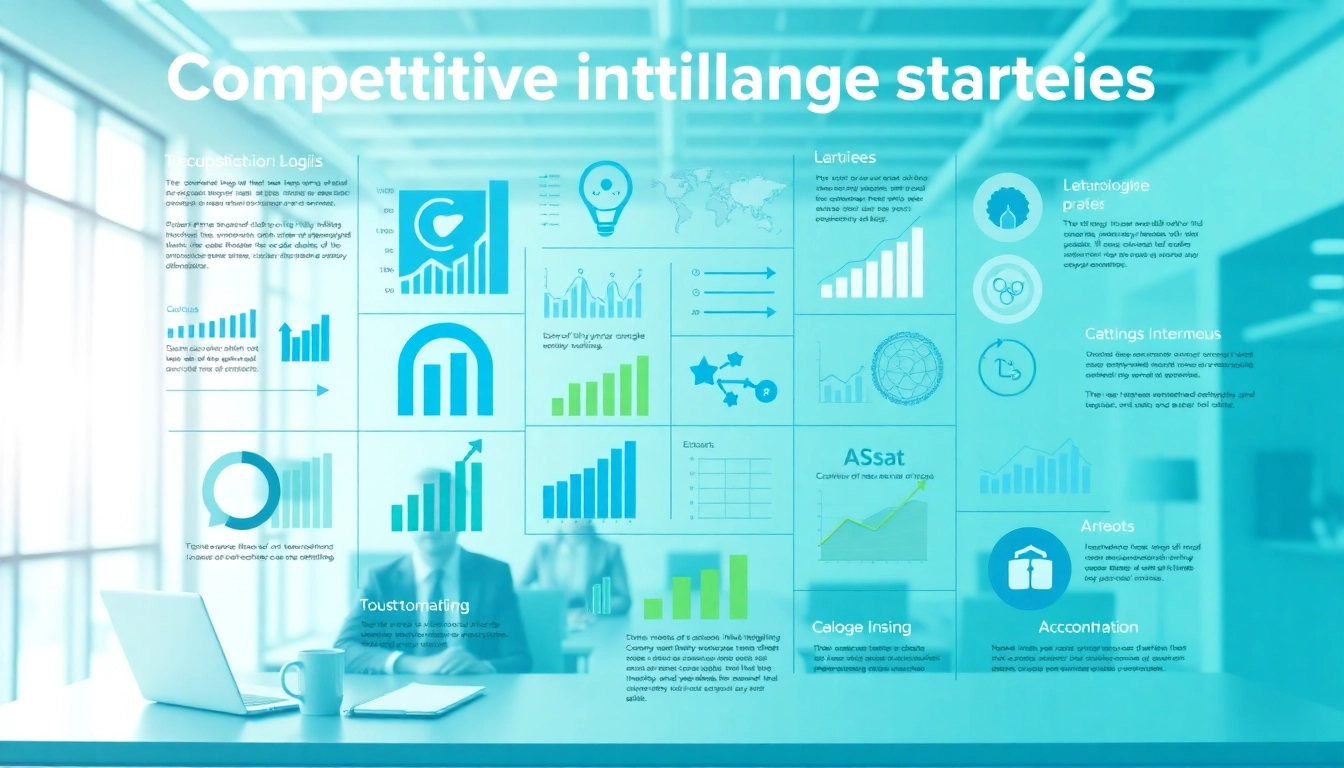
Understanding Competitive Intelligence
Competitive intelligence (CI) refers to the systematic gathering, monitoring, analysis, and dissemination of external information crucial for strategic decision-making within an organization. This includes insights not only about competitors, customers, and markets but also technological advancements and industry trends. CI helps businesses to navigate competitive landscapes, anticipate market changes, and adapt their strategies accordingly. In today’s fast-paced business environment, understanding competitive intelligence is more important than ever for sustainable growth and success.
Definition and Importance
Competitive intelligence is not merely about spying on competitors; it is about gathering legitimate, ethical information to make informed decisions. CI allows organizations to understand their standing in the marketplace, assess risks and opportunities, and make data-driven decisions. The importance of CI can be highlighted through several aspects:
- Informed Decision-Making: CI provides leaders with the information they need to make strategic choices. Organizations can understand market dynamics and competitive positioning, leading to better-informed decisions.
- Risk Mitigation: By analyzing competitor actions and market shifts, businesses can proactively identify potential threats, thereby minimizing risks associated with new product launches or business ventures.
- Opportunity Identification: CI enables businesses to spot market opportunities—be it in product development, partnerships, or new market entries—by understanding gaps and trends within the competitive landscape.
Key Components of Competitive Intelligence
The CI process involves several key components that equip organizations to gather and analyze necessary data effectively. These elements include:
- Data Collection: CI begins with collecting various types of data from both primary and secondary sources, including market reports, customer feedback, and competitor pricing strategies.
- Analysis: After gathering data, it must be analyzed to identify patterns, threats, and opportunities. Techniques such as SWOT analysis (Strengths, Weaknesses, Opportunities, Threats) are often employed.
- Dissemination: The final step involves sharing actionable insights with key stakeholders. Reports, presentations, or dashboards may be created to communicate findings effectively.
Difference Between Competitive Intelligence and Market Research
While both competitive intelligence and market research are invaluable for any business strategy, they serve different purposes. Market research focuses on gathering information about customers, their preferences, and how they interact with products or services. In contrast, competitive intelligence zeros in on direct competitors and external factors impacting the industry. To illustrate the difference:
- Market Research: Often involves surveys, focus groups, and consumer behavior analysis aimed at product development.
- Competitive Intelligence: Entails analyzing competitor strategies, actions, and market positioning to stay ahead in the industry.
Methods for Gathering Competitive Intelligence
Primary and Secondary Data Sources
Gathering competitive intelligence involves utilizing both primary and secondary data sources. Primary sources consist of data collected directly from the market, while secondary sources derive from existing literature or data repositories.
- Primary Sources: Surveys, interviews, observations, and direct interactions provide firsthand information about consumer preferences and competitor strategies.
- Secondary Sources: These can include market reports, academic journals, news articles, industry publications, and governmental databases that offer historical context and strategic insights.
Surveys and Interviews in Competitive Intelligence
Surveys and structured interviews are powerful tools for gathering primary data. They allow businesses to capture insights directly from customers and industry insiders. Crafting effective surveys involves careful consideration of:
- Question Design: Questions should be clear and concise, focusing on specific aspects of competitor products or services.
- Sample Selection: Define a target audience that accurately represents your customer base and decision-makers to ensure relevant data is collected.
- Analysis of Feedback: After collecting responses, analyze them to uncover trends or sentiments towards competitors.
Technological Tools and Software
Technological advancements have led to the development of numerous tools and software that simplify competitive intelligence gathering and analysis. These tools can automate processes, helping businesses to focus on strategy rather than manual data collection. Examples of such tools include:
- SEMrush: This tool provides insights into competitors’ web traffic, SEO strategies, and advertising performance.
- SimilarWeb: Offers data on website traffic sources, user engagement, and market share analysis.
- BuzzSumo: This tool helps track industry trends and competitor content strategies highlighting social media performance.
Analyzing Competitive Data Effectively
Data Interpretation Techniques
Data analysis in competitive intelligence is vital for turning raw information into actionable insights. Various techniques can enhance the interpretation of data:
- SWOT Analysis: Strengths, Weaknesses, Opportunities, and Threats can help visualize the competitive landscape.
- Benchmarking: Comparing your performance and strategies against competitors identifies areas for improvement and best practices.
- Trend Analysis: Examining market trends over time helps businesses anticipate changes and adjust their strategies proactively.
Common Pitfalls in Analysis
Analyzing competitive data can be fraught with challenges. Common pitfalls include:
- Confirmation Bias: Relying on data that supports preconceived notions instead of considering all available information.
- Overreliance on Quantitative Data: Ignoring qualitative insights can lead to incomplete analysis. Both types of data are crucial for comprehensive understanding.
- Not Updating Data: Market conditions change; therefore, regularly updating data sources is necessary for accurate insights.
Turning Analysis Into Actionable Insights
After data analysis, the next crucial step is translating findings into actionable insights. This involves:
- Developing Recommendations: Based on the analysis, formulate recommendations for strategic initiatives.
- Prioritization: Use a scoring system to prioritize actions based on potential impact and urgency.
- Implementation Planning: Create a clear roadmap outlining steps, responsibilities, and timelines for executing strategies based on CI findings.
Implementing Competitive Intelligence in Business Strategy
Developing a CI Strategy
Establishing a competitive intelligence strategy starts with defining clear objectives. Organizations must:
- Identify Goals: Set specific goals such as improving market share, launching a new product, or entering a new market segment.
- Allocate Resources: Designate a team and budget for CI activities to ensure it is prioritized and executed effectively.
- Choose the Right Tools: Select appropriate data collection and analysis tools in line with organizational goals.
Integrating CI into Decision-Making Processes
To maximize the benefits of competitive intelligence, organizations must integrate CI insights into their decision-making processes:
- Cross-Functional Collaboration: Encourage collaboration across departments (marketing, product development, sales) to ensure CI is applied consistently.
- Regular Briefings: Schedule regular updates for business leaders to discuss CI findings and their implications for strategy.
- Feedback Mechanisms: Create a structured feedback process that allows teams to provide input on CI efforts and results.
Case Studies of Successful CI Implementation
Several organizations exemplify successful competitive intelligence implementation:
- IBM: IBM employs extensive CI processes to analyze both tech trends and competition, enabling them to stay ahead in technology innovation.
- Amazon: Amazon regularly conducts CI to understand customer preferences and competitor pricing strategies, helping them maintain a competitive edge in the retail space.
- Netflix: Leveraging viewer data and competitor insights has allowed Netflix to customize content and maintain subscriber growth in a competitive industry.
Measuring the Impact of Competitive Intelligence
Key Performance Indicators for CI
To evaluate the effectiveness of competitive intelligence efforts, organizations should establish clear key performance indicators (KPIs). Examples of KPIs for measuring CI success include:
- Market Share Growth: Monitoring changes in market share before and after CI implementation indicates how well strategies are performing.
- Revenue Growth: Analyzing how revenue evolves as a result of actionable insights gained from CI efforts.
- Customer Retention Rates: Improving customer retention indicates successful understanding of competitive dynamics and customer needs.
Feedback Loops and Continuous Improvement
Feedback loops are critical for the continuous improvement of CI processes. Organizations should:
- Regularly Review CI Processes: Evaluate the effectiveness of current CI methods and make adjustments as needed.
- Incorporate Team Feedback: Soliciting input from team members involved in CI encourages perspectives that can enhance data collection and analysis.
- Adapt to Market Changes: Staying agile in the face of market changes is necessary for CI relevance and effectiveness over time.
Future Trends in Competitive Intelligence
The field of competitive intelligence is continually evolving. Emerging trends to watch include:
- AI and Machine Learning: Utilizing AI can enhance data analysis capabilities and identify patterns that manual analysis may overlook.
- Real-Time Data Analysis: The demand for instant access to competitive insights is rising; businesses are increasingly adopting tools for real-time analytics.
- Ethical CI Practices: As industries become more scrutinized under regulatory frameworks, ethical considerations in CI practices will play an important role in shaping strategies.





